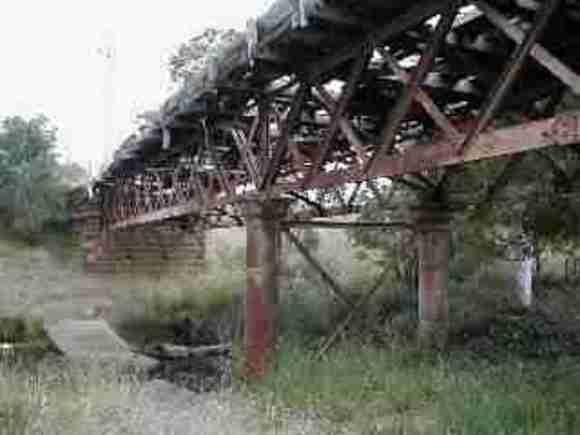| Back to search results » | Back to search page » |
|
Pitfield Bridge over Woady Yallock Creek
LocationRokewood-Skipton Road,, PITFIELD VIC 3351 - Property No B7227
File NumberB7227LevelState |
|
Statement of Significance
What is significant? Pitfield Bridge is a riveted metal Warren Truss bridge on bluestone abutments. The Bridge is a total length of approximately 53 m overall, comprising two spans of 26 metres. It is located south of the existing road on a bypassed crossing with sharply angled approaches. The bluestone abutments (probably relating to an earlier strutted timber beam bridge of c1870) are teamed with deep but lightweight riveted wrought iron Warren Trusses, a central pier of two riveted wrought iron cylindrical columns, and timber cross planking and longitudinal timber decking with scarf-jointed timber kerbs.
How is it significant? Pitfield Bridge is significant for aesthetic/architectural, historic, and scientific (technical) reasons at a State level.
Why is it significant? The Pitfield Bridge is of historical significance for its association with an important pre-gold route once known as the Upper Portland Road, and one of the major connecting routes between the Western District and the ports of Portland and Geelong. A series of important early metal bridges (Pitfield, McMillans, Shelford) as well as some substantial bluestone arch bridges (Winchelsea, Waurn Ponds) survive on this route as a unique collection, which reflect the significance of the road in the second half of the nineteenth century as a main route for commerce and communication between the Western District and Melbourne, Geelong and Portland markets and ports. The route provided outlets for wool and agricultural produce, as well as gold from diggings between Ballarat and Stawell. The Pitfield Bridge and other bridges along the route also reflect the influence, expertise and technical development of local designers, engineers and metal works in the regional cities of Geelong and Ballarat.
It is of technical significance for its highly refined Warren Truss design which incorporates chords of variable section based on the differential stresses in each part of the bridge. That is, the thickness and number of diagonal members reduces from the ends to the middle of the spans in response to the increased loads closer to the bearing points. Although documented confirmation is yet to be found, there is a high probability that this is a design which draws on the work of Melbourne University engineering department Professor Kernot, in the same way that the nearby McMillans Bridge also demonstrates this design development.
It is of aesthetic or architectural significance as a rare and intact survivor of a late nineteenth century, metal truss bridge on stone abutments. The stonework is of classical proportions and fine finish reflecting the skills of stonemasons and the bridge designer with subtle finishes such as drafted margins to the corner stones, projecting string courses and curved wing walls.
The current condition of the bridge, while dilapidated, creates a very picturesque quality.
Classified: 08/09/2004
Group
Transport - Road
Category
Road Bridge




